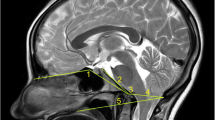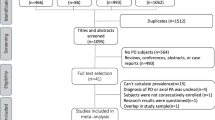Abstract
Study Design
Case report.
Introduction
Pisa syndrome (pleurothotonus) is a rare neurologic syndrome, often considered as a consequence of long-term treatment with neuroleptic drugs, defined as more than 10 degrees tonic lateral flexion in upright spine without any significant associated vertebral rotation resembled the leaning tower of Pisa. Unfamiliarity of many neuro- and orthopedic surgeons with this syndrome can lead to unnecessary diagnostic and therapeutic interventions.
Case Report
A 33-year-old woman, who has been treated as a schizophrenic patient for 16 years, was referred to our spine clinic with signs of trunk shift. She was consuming valproic acid 500 mg twice a day and clozapine 100 mg three times daily, as an unchanged regimen for the past 2 years. Few months after treatment with clozapine, her parents noticed that the patient progressively leaned to one side. Physical and imaging examinations revealed a severe left truncal shift associated with right cervical tilt. Drug regimen was changed and clozapine dosage reduced to 200 mg daily, and bipyridine 2 mg daily was added to the therapeutic regimen. By 1 month, the deformity gradually disappeared and normal body posture was restored. At the last follow-up visit, 28 months later, normal body posture was observed to be maintained, and no evidence of spinal deformity was noted.
Conclusions
Spine deformity surgeons visiting patients with abnormal postures of the trunk need to ask the patient about medications they are receiving and should be aware of their neuropsychiatric complications. Even drugs with the minimum risk of dystonia, such as clozapine, may cause dystonic disorders like Pisa syndrome.
Similar content being viewed by others
References
Schwab FJ, Smith VA, Biserni M, et al. Adult scoliosis: a quantitative radiographic and clinical analysis. Spine 2002;27:387–92.
Suzuki T, Matsuzaka H. Drug-induced Pisa syndrome (pleurothotonus): epidemiology and management. CNS Drugs 2002;16:165–74.
Chen HK, Wu BJ, Shao CH. Drug-induced Pisa syndrome associated with aripiprazole during clozapine treatment. Prog Neuropsychopharmacol Biol Psychiatry 2010;34:707–8.
Pan PY, Chou HW, Cheng CC, et al. Pisa syndrome induced by paliperidone. J Neuropsychiatry Clin Neurosci 2014;26:E3–8.
Yeh YM, Chen YC, Chen CK, et al. Chronic Pisa syndrome associated with switching antipsychotics from olanzapine to ziprasidone. Prog Neuropsychopharmacol Biol Psychiatry 2009;33:162–3.
Walder A, Greil W, Baumann P. Drug-induced Pisa syndromeunder quetiapine. Prog Neuropsychopharmacol Biol Psychiatry 2009;33:1286–7.
Ekbom K, Lindholm H, Ljungberg L. New dystonic syndrome associated with butyrophenone therapy. Z Neurol 1972;202:94–103.
Cordeiro Q, Zung S, Vallada H. Pisa syndrome induced by rapid increase and high dosage of risperidone. Arq Neuropsiquiatr 2008;66:896–7.
Shinfuku M, Nakajima S, Uchida H, et al. Pisa syndrome caused by an acetylcholinesterase inhibitor in a patient with dementia with Lewy bodies. Psychiatry Clin Neurosci 2011;65:299.
Cossu G, Melis M, Melis G, et al. Reversible Pisa syndrome (pleurothotonus) due to the cholinesterase inhibitor galantamine: case report. Mov Disord 2004;19:1243–4.
Uemura T, Kasai Y, Araki K, et al. Pisa syndrome. J Spinal Disord Tech 2008;21:455–7.
Marchione P, Spallone A, Valente M, et al. Reversible Pisa syndrome associated to subdural haematoma: case-report. BMC Neurol 2014;14:149.
Hazari N, Kate N, Grover S. Clozapine and tardive movement disorders: a review. Asian J Psychiatr 2013;6:439–51.
Kurtz G, Kapfhammer HP, Peuker B. Pisa syndrome in clozapine therapy. Nervenarzt 1993;64:742–6.
Hung TH, Lee Y, Chang YY, et al. Reversible Pisa syndrome induced by clozapine: a case report. Clin Neuropharmacol 2007;30:370–2.
Doherty KM, van de Warrenburg BP, Peralta MC, et al. Postural deformities in Parkinson’s disease. Lancet Neurol 2011;10:538–49.
Schmid CL, Streicher JM, Meltzer HY, et al. Clozapine acts as an agonist at serotonin 2A receptors to counter MK-801-induced behaviors through a barrestin2-independent activation of Akt. Neuropsychopharmacology 2014;39:1902–13.
Author information
Authors and Affiliations
Corresponding author
Additional information
Author disclosures: FF (none); FO (none); AB (none).
Rights and permissions
About this article
Cite this article
Faridhosseini, F., Omidi-Kashani, F. & Baradaran, A. Pisa Syndrome Associated With Clozapine: A Rare Case Report and Literature Review. Spine Deform 3, 386–389 (2015). https://doi.org/10.1016/j.jspd.2015.02.003
Received:
Revised:
Accepted:
Published:
Issue Date:
DOI: https://doi.org/10.1016/j.jspd.2015.02.003




